Hello, Internet! Hello, IULMIA Fan Club members! My name is Amber Bertin and I am one of the Assistant Film Archivists working for the Indiana University Libraries Moving Image Archive (IULMIA) on the Media Digitization and Preservation Initiative (MDPI), which you can read more about here. My role on the MDPI project is to inspect, identify, and make selection decisions on which film materials are sent to our digitization vendor or, to put it in terms more relevant to you, which titles and specific copies of titles you are going to be able to watch online at the end of this project. Some are even available right now! Check them out here. Today, I’m going to take you through a case study in my selection process – the processing of one of the boxes handed over to IULMIA by University Archives, but first some background:
For about a year now, I have been working on the Audio-Visual Center collection. The Audio-Visual Center collection is not only the archive’s largest collection, it’s also its core collection. From the 1910s through the 1990s, under various names on the Indiana University campus, the Audio-Visual Center (AVC) served as one of the largest distributors of educational films in the United States. AVC also produced its own educational films and several of the people associated with it were integral in operating the film distribution wing of National Educational Television, the pre-cursor to PBS. When the Moving Image Archive was founded in 2010, we took custodianship of this collection and since then, we have continued to discover more AVC materials spread across multiple units, departments, and locations around campus. As we find these materials, we have made a concerted effort to re-unify the collection. Our most recent acquisition was approximately 2000 films from University Archives.
When these University Archives materials came to IULMIA, I had been working through IULMIA’s AVC-produced prints and elements for several months and had started to notice some interesting anomalies. Typically, when I assess titles for MDPI candidacy, I am trying to put together what I colloquially refer to as a “preservation package”. This means I am looking for a composite print (a complete copy of the film that has sound and image together), an image element (a complete image negative or internegative that would have been the source of the image on the print), and a sound element (a complete and final mix optical or magnetic track that would have been the source of the audio on the print). There are normally several copies and several generations of varying quality and completeness of each category that I need to compare before making a decision on what is sent to our digitization vendor; however, these AVC-produced titles were different. Many of the titles seemed to be missing items. A title might have a print and an internegative, but not sound elements or it might have elements, but not prints, and so forth. Further, there were several prints that had print-through information from previous generations that I couldn’t locate. This meant I was having to move forward with a lot of incomplete “preservation packages” and/or with prints that I knew were potentially not the best copy in existence.
This all changed when the materials from University Archives started to arrive. When I started to look at these materials, I noticed that a lot of these items seemed to be the missing elements and earlier prints I was previously unable to locate. Additionally, a lot of brand new, previously unknown AVC-produced titles were among these materials. Essentially, I had a whole new treasure trove of materials with which to work and I was very excited.
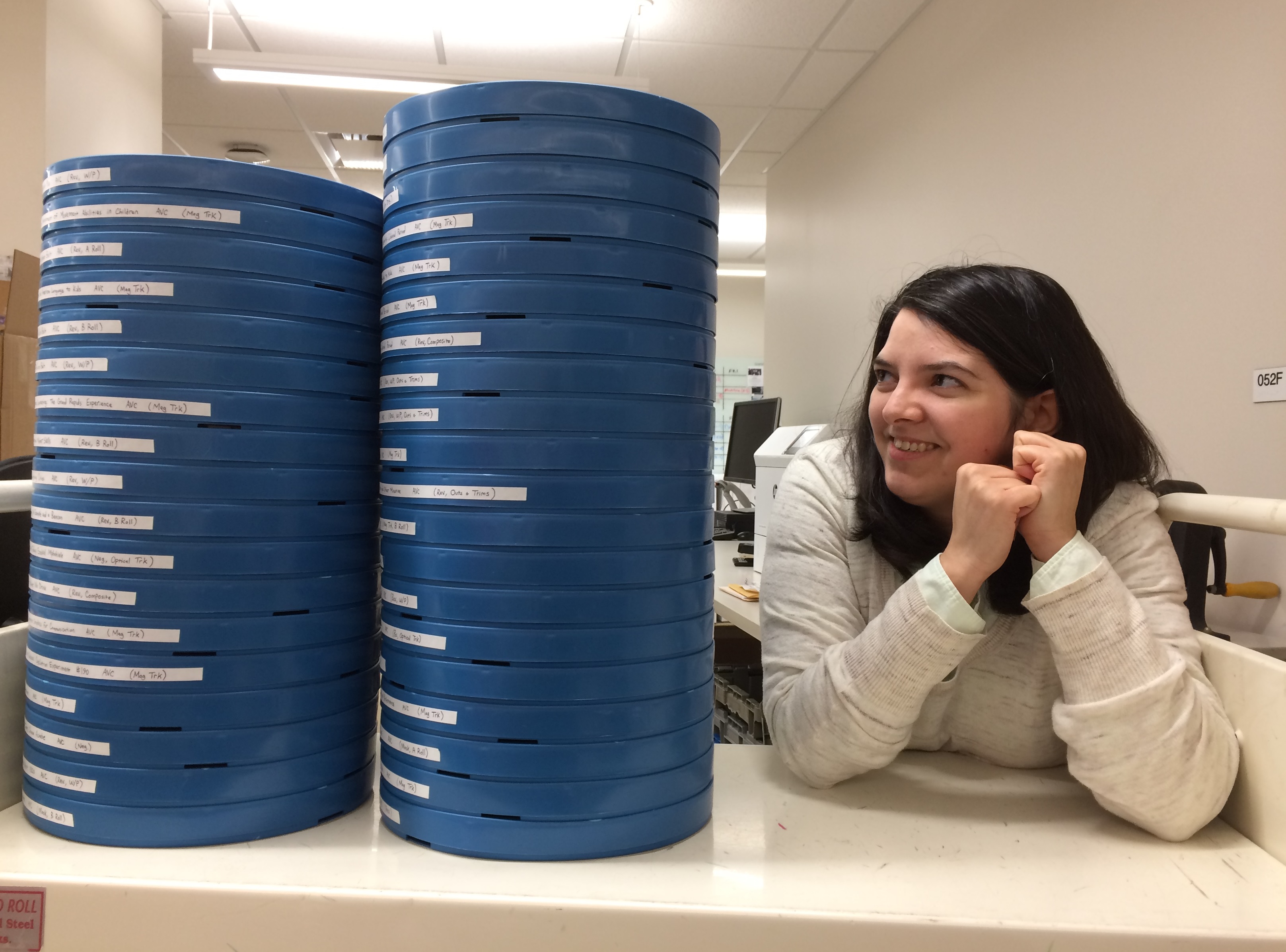
Now, let’s talk about how the materials from University Archives came into IULMIA’s collections and what happens to those materials after they arrive. The initial conversations about the films moving started several years ago, but it wasn’t until I started processing the AVC-produced titles and discovered so many crucial missing items from our MDPI digitization packages, that re-unifying these materials under one collection holder became critically necessary. In order to make this happen, several people from both archives had to get together to discuss the logistics of the move – did both sides agree to this move, was it in the best interest of the collection, did this move advance the collection mandate of both archives, how was it going to affect researchers, how was it going to affect other types of access, how would we physically move the materials, how would we maintain communication about this collection, among many other considerations. My colleagues Andy Uhrich and Carmel Curtis, as well as Dina Kellams and Brad Cook from University Archives took the lead during this process, so I want to highlight their work and take a moment to say how much I appreciate working in such a great, collaborative environment with all of them. I also want to highlight the fact that University Archives did an exceptional job conserving these materials for the past decade and both the IU-community and the larger film scholarship community should be incredibly grateful for them doing so.
Next, we had to merge all of the existing University Archives metadata with IULMIA’s existing metadata system. This process is on-going as we continue to process, inspect, and collect additional metadata from these materials, but it started with a word document that looks like this:
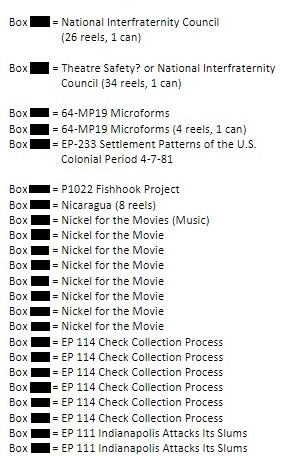
That’s a sample page from the very long word document we received from University Archives detailing all of their existing metadata for these materials. One of our wonderful student workers, Kathryn Jankowski, took that word document and turned it into a spreadsheet so that I could more easily re-organize, filter, categorize, and otherwise quickly manipulate all of this data during my research and selection process. This task alone took several months of painstaking, meticulous work, but without it, my work on these materials would be impossible, so it’s not an understatement to call Kathryn my hero.
Two other student heroes who have worked very closely with me on this project and whose work I also want to highlight, are Zeynep Yasar and Dan Hassoun. At the end of the University Archives-AVC Re-allocation project, either Zeynep or Dan will have touched every single item we received from University Archives. After each item is pulled, Zeynep and Dan open each can, verify the title, and collect metadata about each item’s generation, base, sound type, color, length, and can size. They also perform AD (Acetate Deterioration) testing on any films suspected of having Vinegar Syndrome (the colloquial term for the chemical decomposition of acetate-base film stock because the film actually starts to smell like vinegar as it begins to decompose) and re-can each item in a brand new, acid-neutral, archive-approved film can. As they do this, they also take pictures of all of the original cans so that we can maintain records of not only what the original cans looked like, but also what was written on them. Plus, they re-barcode each item, which is a necessary step so that our lovely colleagues who manage the university’s special collections storage facility can accurately update their database by de-accessioning all of these items from University Archive’s custodianship and re-accessioning them with the new barcodes under IULMIA’s custodianship. All of this is an incredible amount of work that not only benefits the long-term health and longevity of these collection materials, it is also absolutely vital to my ability to efficiently work through these materials and make my selection decisions. For instance, if I’m looking for a picture negative for a particular title for which there are five entries on the spreadsheet, three of which Dan has identified as prints and two of which Dan has identified as black and white picture negatives, he has just saved me the time and labor of pulling and inspecting all five reels of film. Instead, I can just pull the two I know match the criteria for which I am looking.
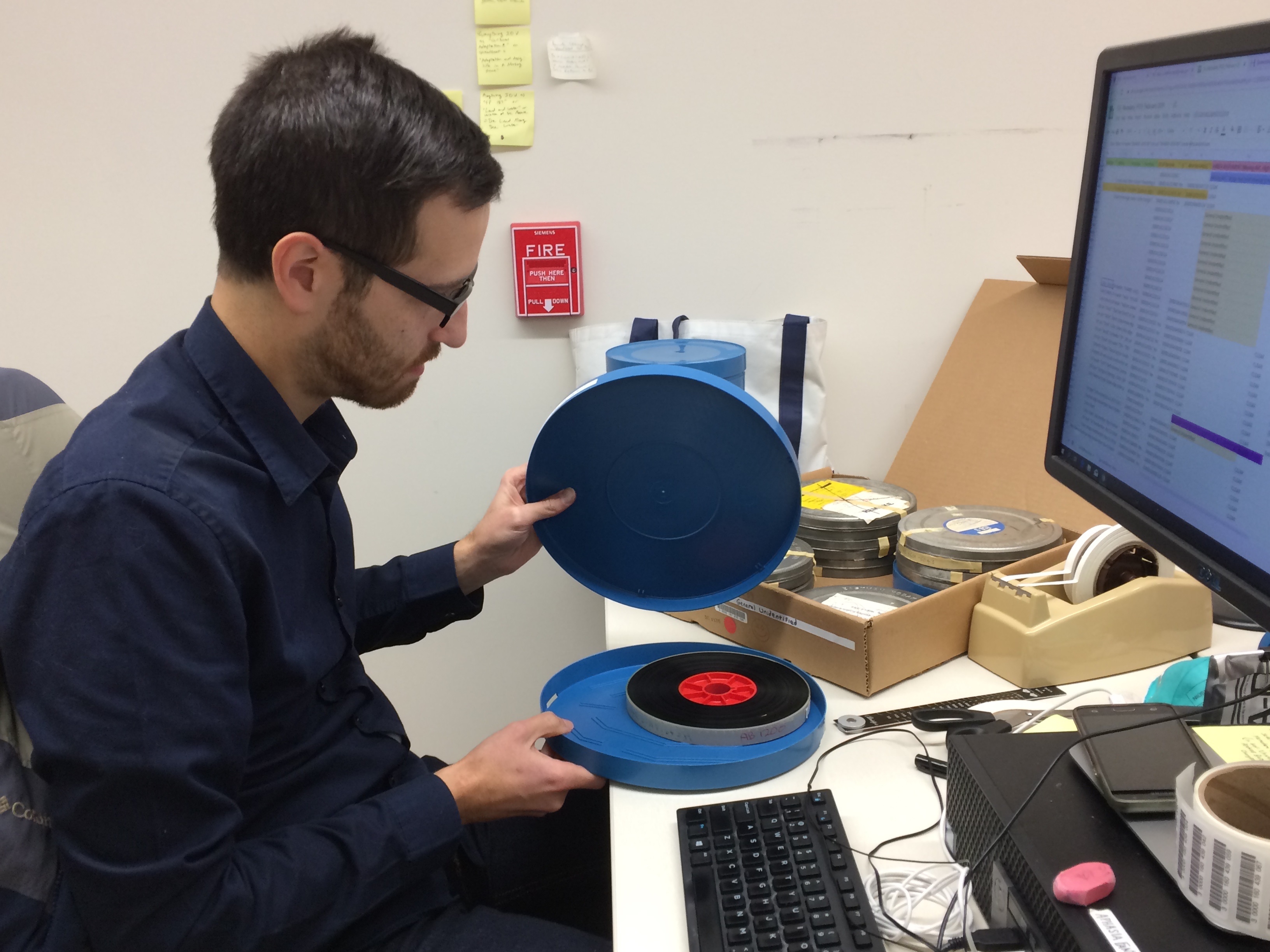
As Zeynep and Dan process these materials, they update each line of the spreadsheet Kathryn made with the new barcode and the metadata they have collected. Additionally, before I started my MDPI selection research on these materials, I labeled and color coded every line of the spreadsheet based on several selection categories: high-value unidentified, general unidentified, missing AVC elements, missing AVC non-faded print, and skip. In order to do this, I researched each title to determine if IULMIA had any pre-existing materials and if we did, if any of those items had previously been assessed for MDPI selection. If they had been assessed, what, if anything, had already been sent to our digitization vendor and what was the quality of those materials? For example, was the print faded (the image looks red because most of the color has disappeared) and/or might the new University Archives materials contain a non-faded print? In order to track my progress, as I worked through the collection, I added two additional categories, “Clear” and “Select”, to indicate if I had chosen to send a particular item to our digitization vendor or not. Here’s an image of what Kathryn’s spreadsheet looks like today as we continue to assess these materials:

Currently, I am working through the “Missing AVC elements” category, which means I am looking for very specific items to complete a previously incomplete “preservation package”. Recently, I was working on a title called Land along the Water. You can view a pre-MDPI standard definition (SD), black and white version here and the 2k, color answer print we sent to MDPI here. As you will notice, the SD, black and white print was very scratched and the scan provides limited detail. Because we are going back to earlier elements and because we are scanning these elements at a higher resolution, we are able to not only better digitally preserve our collections, but also to provide access to better looking, more accurate digital copies of our collections. In the MDPI scan, you can now see the full-range of color and a higher level of detail in the image; and, because the color answer print we sent was in much better physical condition than the black and white print, you are much less distracted by scratches, dirt, and other physical damage.
As I was working through the materials University Archives sent over related to The Land Along the Water, I pulled all of the items listed on the spreadsheet with that title or similar titles. I pull similar titles as well because most of the previously collected title metadata for these items was taken from a direct transcription of the writing on the original cans, which is not necessarily the authority title we now refer to the film as. The film might have had a different title while in production or the person writing on the can might have used abbreviations, or any number of other combination of words to refer to the content that ended up being the authority title, so in order to make sure I am looking at everything for a specific title at the same time, I have to do some creative searching. When the The Land along the Water items arrived, instead of being a single item in a single film can, one of the items came in a cardboard box that looked like this:
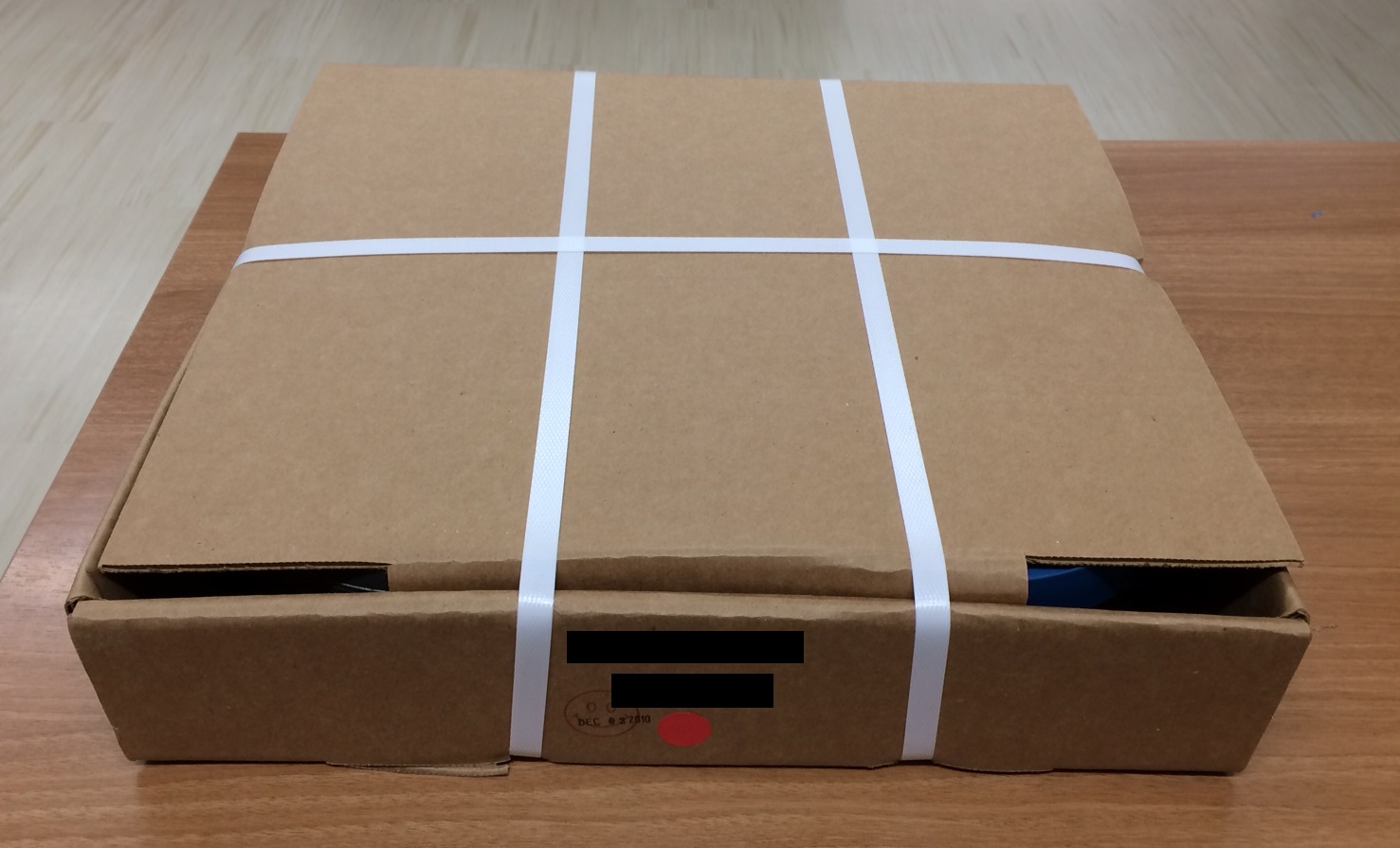
This isn’t unusual for this collection. Previous archivists decided to consolidate the storage of and increase the security of these materials by placing up to twelve 400ft. cans in these sealed cardboard boxes. The challenge for me is that typically, these cardboard boxes are a bit of a grab bag – you don’t know what’s inside until you open it. On the spreadsheet, one box can have anywhere from one entry to twelve, meaning there might be a single title or twelve different titles inside. It is also possible that multiple reels will be inside a single can. Also, the box itself is barcoded, but the individual cans inside are not, so all twelve cans share the same barcode, which is an impossibility for both IULMIA’s internal database and the MDPI workflow, both of which rely upon a one item, one barcode standard. This is another reason why we are re-barcoding every single item – to conform these items to IULMIA’s cataloging system. Finally, these boxes being sealed when they arrive on my desk indicates that Dan and Zeynep have not handled any of these materials yet, meaning they have not collected any generational, conditional, or authority title metadata. I only have the original metadata sent over from University Archives to help me discern what is in the box. This usually includes only the barcode, accession number, box number, and title from the can, which in my experience with this collection is incorrect approximately 40% of the time. Sometimes items get misidentified, cans get switched, or writing on cans is hard to read. It happens in all special collections. This is why we “trust, but verify” and why Dan, Zeynep, and I always look for a title on the print itself.
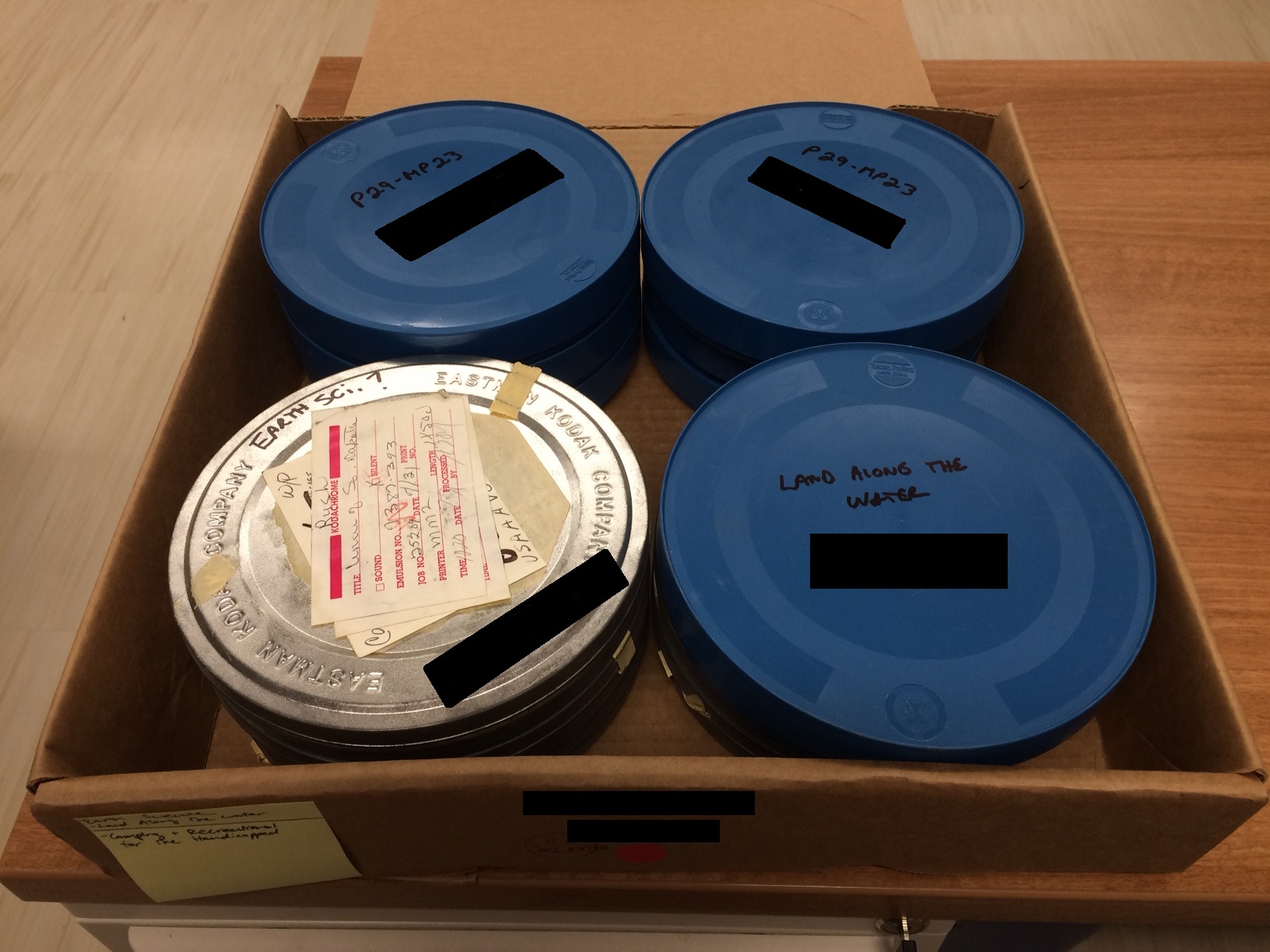
The first thing I do when I open one of these boxes is organize the films based on the titles they are identified as on the spreadsheet/the text written on the can. In this particular case, there was one item for The Land along the Water, which was the reason I pulled this box. There were five items identified as Earth Science, which is actually not a single title, but a series. It also happens to be the series to which The Land along the Water belongs. Finally, there were six items identified as Camping and Recreational […] for the Handicapped, which is also not a single title, but refers to two different titles, Camping and Recreational Facilities for the Handicapped, which you can watch here, and Camping and Recreational Programs for the Handicapped, which you can watch here. Although, I only pulled this box because of The Land along the Water, I still looked at the other 11 reels, particularly because there seemed to be unclear titling and I wanted to attempt to identify the correct title so that we could have accurate metadata. Further, these other titles were marked on the spreadsheet as titles that needed additional selection research. However, even if neither of these were the case, I would still look at each item while they were on my desk, at least to do a title verification and to collect basic generational and conditional metadata.
Next, I do a very quick initial assessment of the films. This involves examining the can, tape, and leader for any information that will help me further organize the films before I start inspecting them. I prefer to inspect all items of the same generation and type together, so this is the main identifying information I look for during this initial survey. Sometimes I also find interesting title information during this process, such as indicated by the picture below of writing on the leader of one of the Camping… films. It says “Bradford Woods”, which is the location of Camp Riley, the camp featured in these films. Discovering this text gave me an additional search term to potentially find additional material related to these titles.

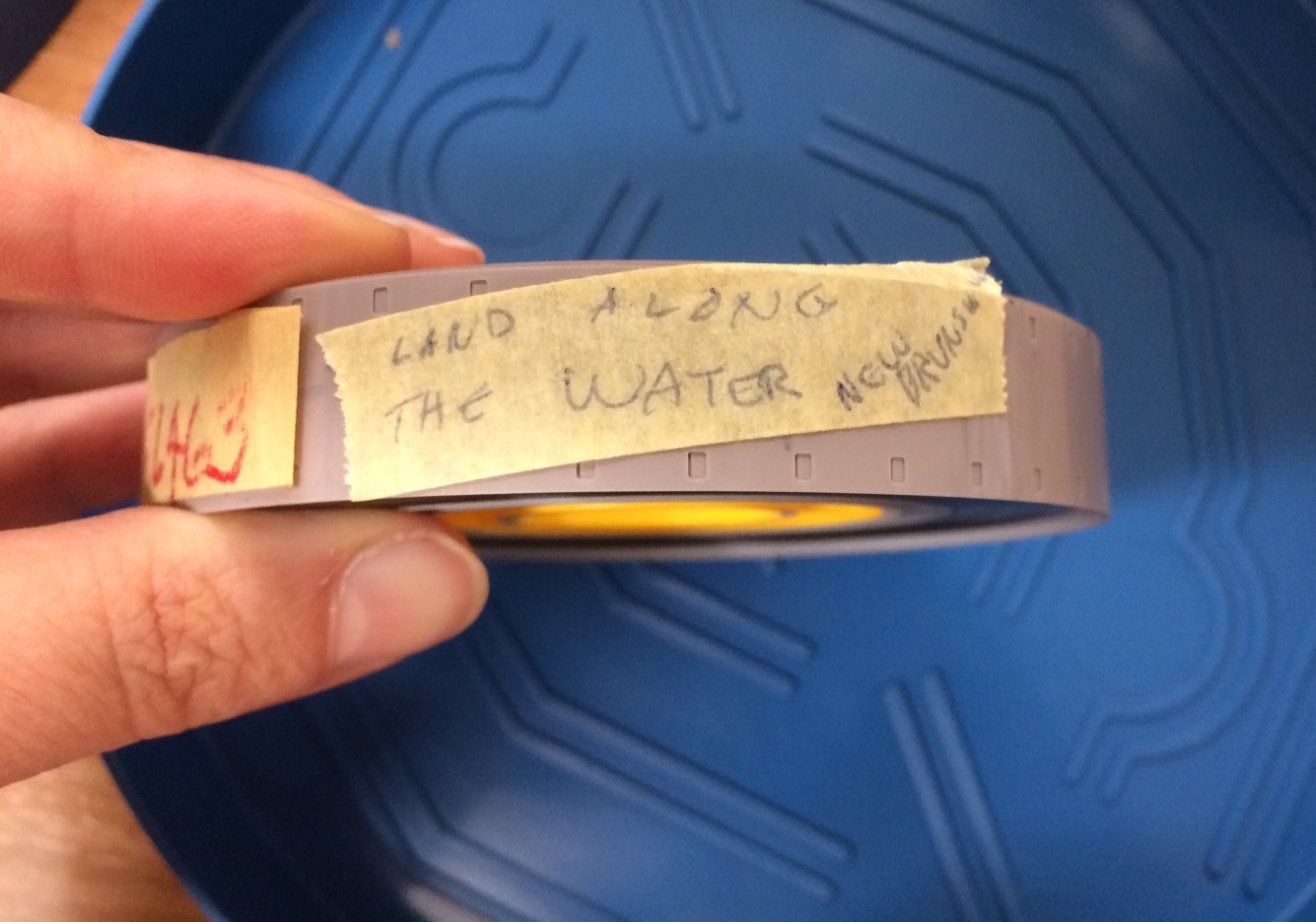
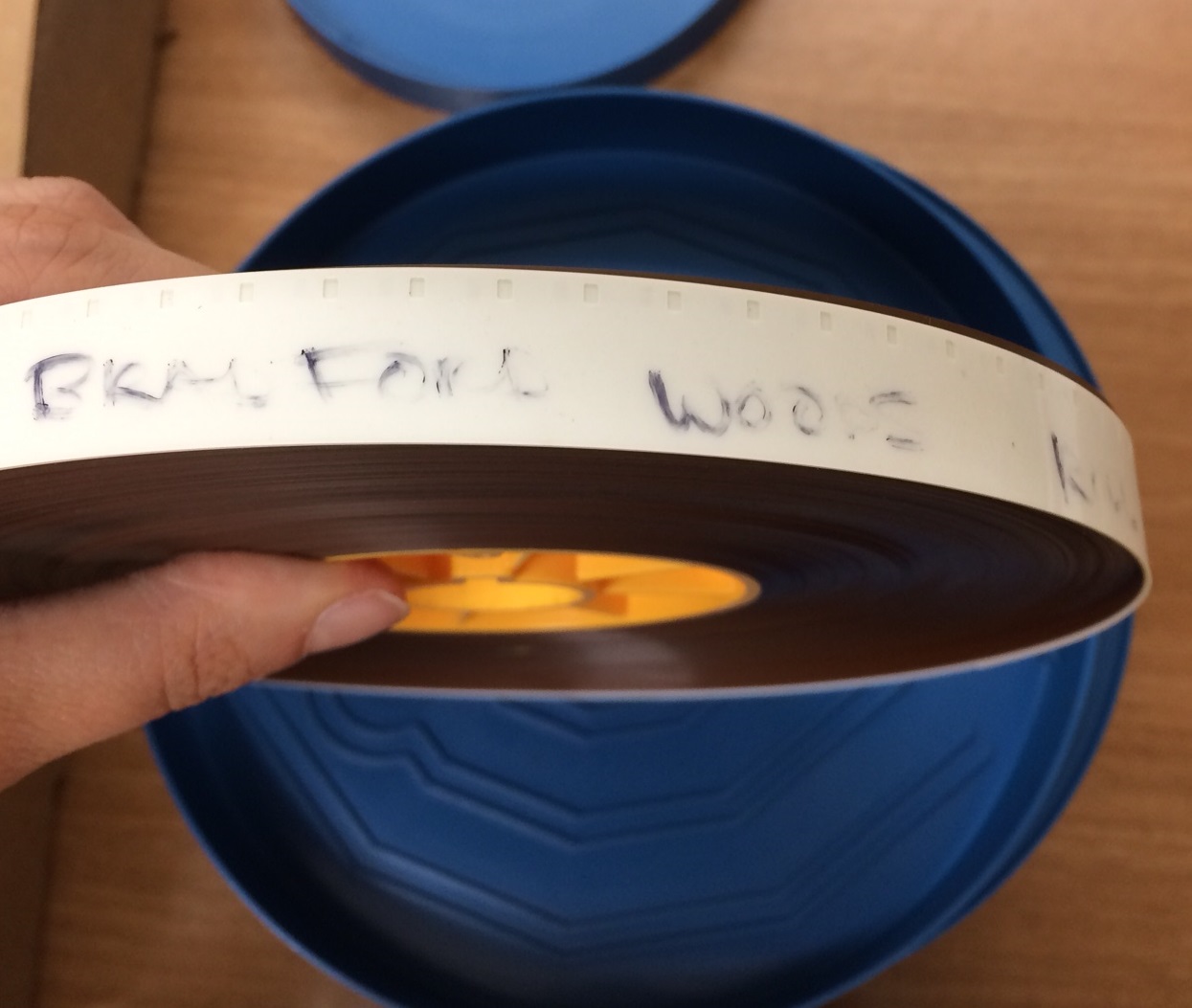
After my initial assessment and organization, I do a more detailed analysis of the materials based upon what each title needs. For The Land along the Water, my notes on the spreadsheet indicated that this title was missing an answer print (the copy of the title that would have been sent to AVC directly from the lab for final approval before the distribution prints were made. These are typically in better condition than the distribution prints, so are preferable for preservation); but I also wanted to look in IULMIA’s internal database to confirm. According to the database, indeed we had already sent an internegative and an optical track negative, but we had also sent a color answer print in the time between when I made my spreadsheet notes and when I pulled this box. Further, based on the answer print’s inspection notes, it was in great physical condition and not faded. This meant I only needed to look at the reel on my desk to confirm the title and collect basic metadata, not for selection research. There was only one problem, when I put the film on my inspection bench, the text on the leader said this:

Those “EP” numbers are internal AVC production codes and the fact that there are two of them indicates that the footage on this reel most likely comes from two different titles. EP 186 refers to Plains and Plateaus and EP 187 refers to The Land along the Water. We don’t have a master list of production codes, so as I have been working through these materials, I have been systematically reconstructing a list of production codes by comparing the codes I find on cans and leader to the content of films and the titles on print. Luckily, when I came across this particular reel, I had already determined which titles were associated with EP 186 and EP 187. That this reel contained footage from both Plains and Plateaus and The Land along the Water was confirmed when I wound into the reel and found images like the ones below. The first is a shot I recognized as being featured in The Land along the Water, the second is part of a title card for Plains and Plateaus.


Both of these titles are part of the Earth Science series, so I assigned this reel the authority title “[Earth Science Series]” and noted that it features footage from both The Land along the Water and Plains and Plateaus. I also noted that the generation of this reel is camera original, meaning this reel of film came directly out of the camera and is thus unedited, raw footage.
Next, I decided to look at the five “Earth Science” reels. As mentioned earlier, “Earth Science” is a series of films, not an individual title, and there are approximately 30 entries in IULMIA’s internal database that are associated with this series. When I did my initial assessment of the films, this is what I found:


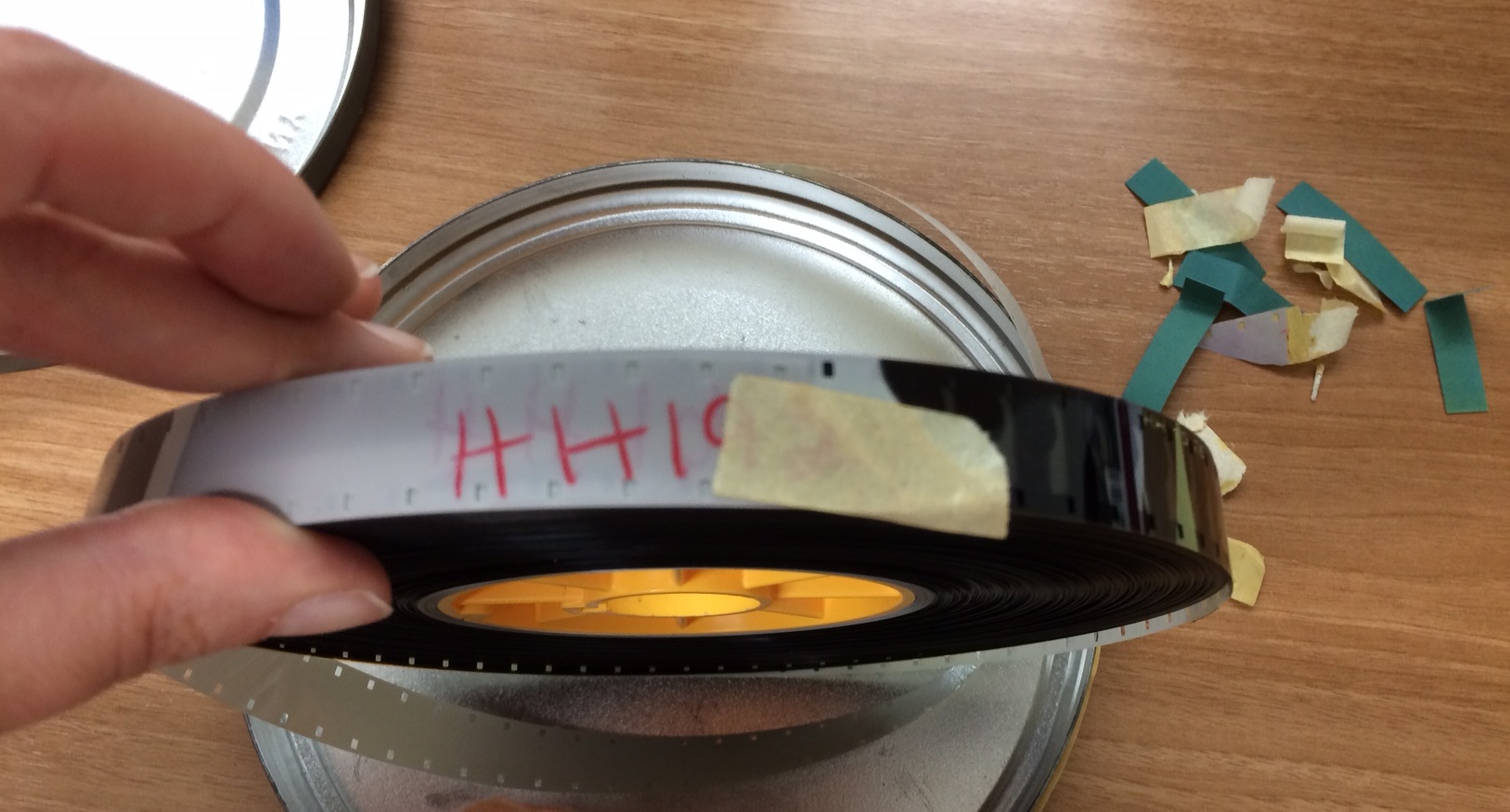
Unlike the reel of footage from The Land Along the Water and Plains and Plateaus, there was no information that pointed me towards a specific title – no title text, no descriptive text, no production code – just “Earth Science”, “Roll ‘C’”, and “HH192-”. These were the only clues I had to go on before I started my inspection. The “Roll ‘C’” text indicated that this reel was probably camera original, as labeling camera original reels like this was common for the AVC staff. The “HH192-” text confirmed it. That number sequence refers to the printed-in footage number closest to that end of the reel, the last number of which is obfuscated. At the other end, AVC staff would have also written a similar number such as “HH2207” to indicate the printed-in footage number at that end. Most commercially produced camera original negative and reversal film stocks have these printed-in sequences along the edge. They appear every foot and increase by one number each time they appear, essentially providing a count of the length of the reel, but more importantly allowing the editor to have a quick reference for orientation and for which shots they want to use. I can surmise exactly what this text refers to before winding into the reel because I have looked at so many AVC cameral original reels at this point, I have learned their internal labelling practices, which is one of the reasons why it is so important and beneficial that when I am doing my selection research, I work through one collection at a time. It allows me to learn the specificities of each collection, which pays dividends in my ability to efficiently identify everything and determine if it is a good candidate for digitization.
Because I knew these reels were camera original reels, I also knew that it was unlikely that these reels would contain any title information. Most likely, I would only find raw images. I decided to watch the files of the previously digitized “Earth Science” films to re-familiarize myself with as much of the content as possible before I attempted a title identification of the six reels of film on my desk. Unfortunately, even after doing this, I could not provide a specific title identification for any of the reels. They all featured shots from multiple titles in the series, which is common for many of the series in the AVC collection. The AVC staff would often shoot the footage for a series in its entirety at the same time and then edit that footage into several films, sometimes using the same shots in many different titles. So, similarly to the reel featuring footage from The Land Along the Water and Plains and Plateaus, I gave all five of these “Earth Science” reels the authority title “[Earth Science Series]” and provided brief notes about the content of each reel.
Finally, I moved on to the six reels identified on the spreadsheet as Camping and Recreational […] for the Handicapped”. I knew that these reels could be one of two different titles, Camping and Recreational Facilities for the Handicapped or Camping and Recreational Programs for the Handicapped, so one of my goals was to identify to which of these two titles each reel belonged. My other goal, according to my spreadsheet notes, was to find answer prints for each of these titles. During my initial assessment of these six reels, I discovered that one was a silent, image reel, while the other five were separate, full-coat, magnetic tracks, meaning they exclusively contained sound. None of the reels was an answer print, so I decided to simply attempt to identify them. I started with the image reel, which was labelled on the leader as “Bradford Woods Roll One”. As I examined the footage, I was able to definitively identify it as Camping and Recreational Programs for the Handicapped because the footage featured camp counselors leading the campers through various activities. This was confirmed by comparing the footage to the file of our previously digitized internegative. I was also able to determine that this was a reel of out and trims, or the footage that was removed from the final edit of the film.
Then, I examined the five separate magnetic tracks. As I had no images to help me identify the title, I decided to listen to the files of the previously digitized track elements for both titles to familiarize myself with the narration, dialogue, and music for each title. I then listened to the unidentified magnetic tracks on the archive’s flatbed viewer, which has a full-coat magnetic head:
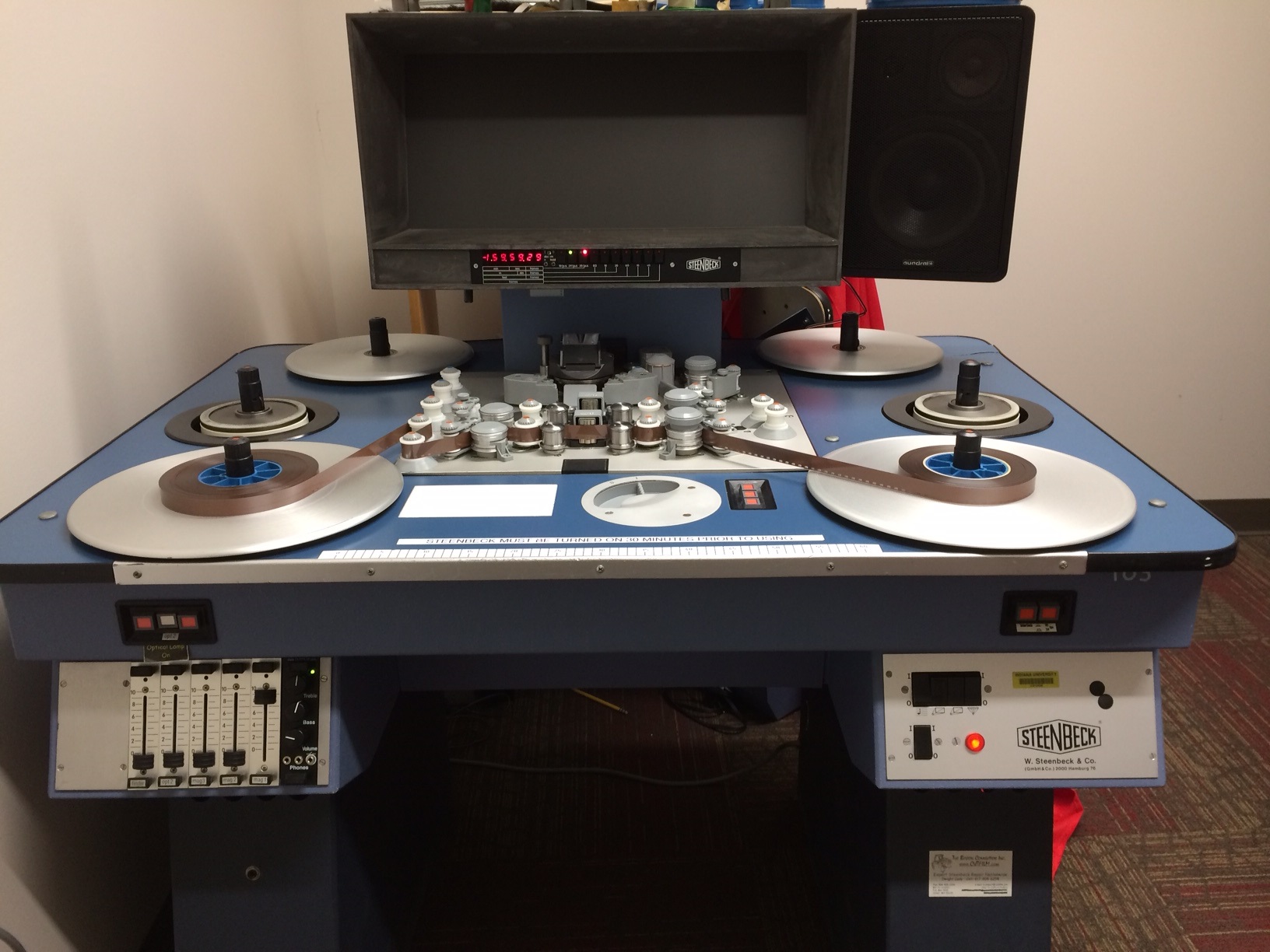
Two of the magnetic tracks featured source audio and interviews with counselors from Camp Riley, the camp featured in the Camping… films, discussing their programs, meaning I was easily able to definitively identify these two reels as original recordings for Camping and Recreational Programs for the Handicapped. The other three reels offered surprises, however. Two of the reels featured interviews with three different men discussing boats, while the third featured a woman’s voice discussing the pelvic area and how it functions while dancing. It was immediately apparent that none of these three reels were related to either of the Camping… films and had been misidentified. Luckily, because I have been working with the AVC collection for such a long time, I am very familiar with the collection, so when I heard the interviews about boats and the discussion of the pelvic area’s role in dancing, two titles from the collection immediately came to mind, The Fourwinds Marina: A Case Study, which you can watch here, and Movement in Classical Dance: The Pelvic Area, which you can watch here. Even more luckily, we had already received the digitized files of the prints for both of these films from our digitization vendor, meaning I could watch and listen to the films to confirm if my theories were correct. After watching the digitized prints, I was able to confirm that the magnetic tracks featuring interviews about boats were in fact raw interview recordings from The Fourwinds Marina: A Case Study and that the magnetic track featuring a woman discussing the pelvic area’s role in dancing was the narration track for Movement in Classical Dance: The Pelvic Area.
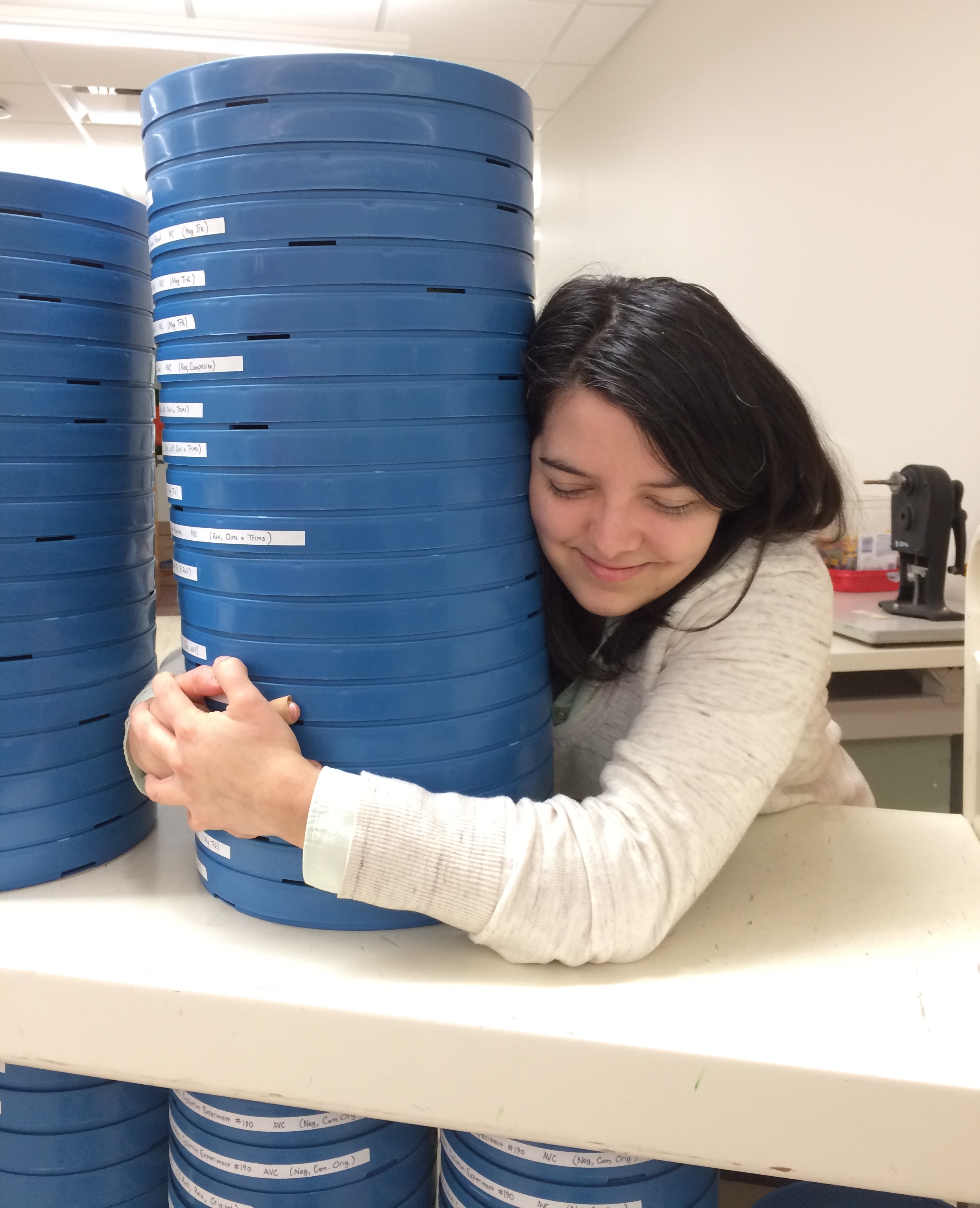
After these title identifications, I had successfully completed processing one of the cardboard boxes moving from University Archive’s collections to IULMIA’s collections. I started with twelve reels in one box. Six of the reels were identified as “[Earth Science Series]” camera original reels. One was identified as outs and trims from Camping and Recreations Programs for the Handicapped. Two reels were identified as original source audio and interviews from Camping and Recreational Programs for the Handicapped. Two reels were identified as raw interview recordings from The Fourwinds Marina: A Case Study and one reel was identified as the narration track for Movements in Classical Dance: The Pelvic Area. Nothing was selected to send to our digitization vendor this time, but through the efforts of our colleagues in University Archives collecting the original metadata and caring for the films all these years, of Kathryn creating a working spreadsheet, of Zeynep and Dan re-canning and re-barcoding every single item, and of me using my detailed knowledge of the AVC collection, we were able to perform the critical task of positively identifying and collecting metadata for all of these reels, which will serve us greatly in our current and future efforts to conserve and preserve these films. Now on to the next box!
1 Comment
Great post, Amber! I was so happy to read that many of your missing production elements arrived in this latest accession. I am experiencing similar issues with the collections here at Michigan State, but with the help of some of my colleagues from the libraries, I’m hoping to also get greater physical and intellectual control of these films. Well done!